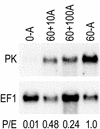Novel protein kinase induced during sporangial cleavage in the oomycete Phytophthora infestans
- PMID: 12455688
- PMCID: PMC126747
- DOI: 10.1128/EC.1.5.687-695.2002
Novel protein kinase induced during sporangial cleavage in the oomycete Phytophthora infestans
Abstract
A study of the effect of inhibitors on zoospore development in Phytophthora infestans demonstrated the involvement of protein kinases and calcium and led to the discovery of a gene induced during zoosporogenesis that encoded a protein resembling Ca2+- and calmodulin-regulated serine/threonine protein kinases. The calcium channel blocker verapamil and the calmodulin antagonist trifluoroperazine inhibited zoosporogenesis and encystment. The protein kinase inhibitors K-252a and KN-93 inhibited zoospore release, encystment, and cyst germination, and K-252a reduced zoospore viability. In contrast, the inhibitors had minor or no effects on sporangia directly germinating in media. Spurred by these findings, a survey of putative protein kinase genes was performed to identify any that were up-regulated during zoosporogenesis. A kinase-encoding gene was identified for which mRNA accumulation was first detected soon after chilling sporangia in water, conditions that induce sporangial cytoplasm to cleave and release zoospores. The transcript persisted in motile zoospores and in germinated cysts but was not detected in other tissues, including hyphae, hyphae placed in water, or directly germinating sporangia. The structure of the predicted protein was novel, as its C-terminal region, which binds calmodulin in related proteins, was unusually short. Concentrations of actinomycin D previously used in experiments that suggested that de novo transcription was not needed for zoosporogenesis or encystment only partially inhibited transcription of the kinase gene, probably due to poor uptake into sporangia.
Figures





Similar articles
-
Activation of zoosporogenesis-specific genes in Phytophthora infestans involves a 7-nucleotide promoter motif and cold-induced membrane rigidity.Eukaryot Cell. 2006 Apr;5(4):745-52. doi: 10.1128/EC.5.4.745-752.2006. Eukaryot Cell. 2006. PMID: 16607021 Free PMC article.
-
RNA-seq of life stages of the oomycete Phytophthora infestans reveals dynamic changes in metabolic, signal transduction, and pathogenesis genes and a major role for calcium signaling in development.BMC Genomics. 2017 Feb 23;18(1):198. doi: 10.1186/s12864-017-3585-x. BMC Genomics. 2017. PMID: 28228125 Free PMC article.
-
Multiple pathways regulate the induction of genes during zoosporogenesis in Phytophthora infestans.Mol Plant Microbe Interact. 2004 Mar;17(3):330-7. doi: 10.1094/MPMI.2004.17.3.330. Mol Plant Microbe Interact. 2004. PMID: 15000400
-
A bZIP transcription factor from Phytophthora interacts with a protein kinase and is required for zoospore motility and plant infection.Mol Microbiol. 2005 May;56(3):638-48. doi: 10.1111/j.1365-2958.2005.04575.x. Mol Microbiol. 2005. PMID: 15819621
-
Regulation and properties of the rat Ca2+/calmodulin-dependent protein kinase IV gene and its protein products.Recent Prog Horm Res. 1997;52:389-406; discussion 406-7. Recent Prog Horm Res. 1997. PMID: 9238860 Review.
Cited by
-
Activation of zoosporogenesis-specific genes in Phytophthora infestans involves a 7-nucleotide promoter motif and cold-induced membrane rigidity.Eukaryot Cell. 2006 Apr;5(4):745-52. doi: 10.1128/EC.5.4.745-752.2006. Eukaryot Cell. 2006. PMID: 16607021 Free PMC article.
-
Activity and Mechanism of Action of the Bioceramic Silicon Nitride as an Environmentally Friendly Alternative for the Control of the Grapevine Downy Mildew Pathogen Plasmopara viticola.Front Microbiol. 2020 Dec 14;11:610211. doi: 10.3389/fmicb.2020.610211. eCollection 2020. Front Microbiol. 2020. PMID: 33381101 Free PMC article.
-
Signal and regulatory mechanisms involved in spore development of Phytophthora and Peronophythora.Front Microbiol. 2022 Sep 9;13:984672. doi: 10.3389/fmicb.2022.984672. eCollection 2022. Front Microbiol. 2022. PMID: 36160220 Free PMC article. Review.
-
A Myb transcription factor of Phytophthora sojae, regulated by MAP kinase PsSAK1, is required for zoospore development.PLoS One. 2012;7(6):e40246. doi: 10.1371/journal.pone.0040246. Epub 2012 Jun 29. PLoS One. 2012. PMID: 22768262 Free PMC article.
-
Genome-wide identification of long non-coding RNAs reveals potential association with Phytophthora infestans asexual and sexual development.Microbiol Spectr. 2025 May 6;13(5):e0199824. doi: 10.1128/spectrum.01998-24. Epub 2025 Mar 26. Microbiol Spectr. 2025. PMID: 40135915 Free PMC article.
References
-
- Ambikapathy, J., J. S. Marshall, C. H. Hocart, and A. R. Hardham. 2002. The role of proline in osmoregulation in Phytophthora nicotianae. Fungal Genet. Biol. 35:287-299. - PubMed
-
- Baldauf, S. L., A. J. Roger, I. Wenk-Siefert, and W. F. Doolittle. 2000. A kingdom-level phylogeny of eukaryotes based on combined protein data. Science 290:972-977. - PubMed
-
- Bigot, J., and J. Boucaud. 2000. Effects of Ca-signalling inhibitors on short-term cold-acclimation of hydraulic conductivity in roots of Brassica rapa plants. J. Plant Physiol. 157:7-12.
-
- Braun, A. P., and H. Schulman. 1995. The multifunctional calcium calmodulin-dependent protein kinase: from form to function. Annu. Rev. Physiol. 57:417-445. - PubMed
Publication types
MeSH terms
Substances
Associated data
- Actions
LinkOut - more resources
Full Text Sources
Miscellaneous

